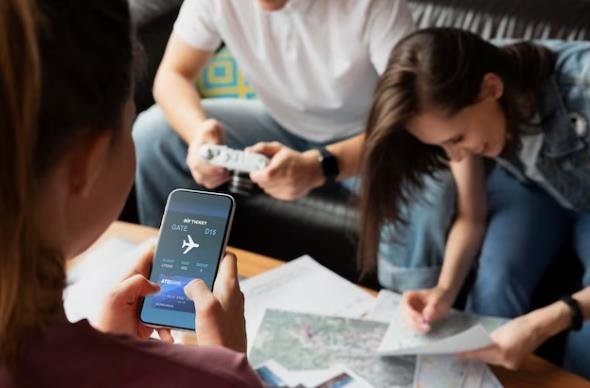As an experienced traveler and tech enthusiast, I understand the need for entertainment and connectivity during long flights. One common question that often arises is about the use of Bluetooth devices on planes. Bluetooth technology, being a staple in our everyday life, can make air travel more comfortable and enjoyable if used correctly.
Have you ever wondered, “Can you use Bluetooth on a plane?” The answer is, yes, you can use Bluetooth on a plane. But it’s not as simple as turning on your device and connecting. There are specific rules and regulations set by airlines regarding the use of electronic devices, including Bluetooth ones, during flights. Understanding these rules ensures a hassle-free journey and helps you make the most out of your Bluetooth devices even while flying. So, buckle up and continue reading to navigate the world of Bluetooth usage on planes.
What is Bluetooth and How Does it Work?
Bluetooth is a wireless technology used for exchanging data over short distances between devices. It uses radio waves on a specific frequency to transmit data securely. You might be familiar with Bluetooth through its common applications like connecting your phone to your car’s audio system, connecting your laptop to a wireless mouse, or pairing your smartphone with wireless earbuds.
Bluetooth operates through a network topology known as a “piconet.” This is a network of devices connected using Bluetooth technology, which can include up to eight devices. Each device in the piconet has a unique address and can either be in an active or standby mode. This means that while you’re using your Bluetooth headphones to listen to a podcast on your phone, you can also connect it to your laptop waiting in standby mode.
According to a report by Grand View Research, the global Bluetooth market size was estimated at USD 4.41 billion in 2020 and is expected to reach USD 5.27 billion in 2021. The Bluetooth market is projected to grow at a Compound Annual Growth Rate (CAGR) of 10.3% from 2021 to 2028. This growth is driven by the increasing demand for wireless connectivity in consumer electronics and other sectors.
The Importance of Airplane Mode During Flights
Airplane mode is a setting available on almost all smartphones, laptops, and similar devices. When activated, it suspends many of the device’s signal transmitting functions – specifically, the ability to send or receive calls or text messages, or use data services. This functionality is crucial during flights as it prevents interference with the aircraft’s navigation and communication systems.
While in airplane mode, your device’s Bluetooth function can still be turned on. This allows you to pair your device with other Bluetooth-enabled devices such as wireless headphones or a wireless keyboard. However, keep in mind that although Bluetooth signals are relatively low range and low power, they can still potentially interfere with aircraft systems. Therefore, airlines have rules about when and how you can use Bluetooth and other wireless devices.

Can You Use Bluetooth on a Plane? Understanding Air Travel Rules
Even though switching to airplane mode disables cellular service, many airlines now offer in-flight Wi-Fi, so you can still browse the internet or send emails during your flight. Remember, however, that this service is often not available during takeoff and landing. It’s always best to adhere to the cabin crew’s instructions regarding electronic device usage during these phases of flight.
How to Use Bluetooth Devices in Airplane Mode
Bluetooth devices can be a great companion during flights, providing entertainment or productivity tools without the need for a cellular connection. However, using them requires a bit of understanding about how airplane mode and Bluetooth interact. When your device is in airplane mode, all its transmitting functions are typically disabled, but you can manually enable Bluetooth.
Here are the steps to use Bluetooth devices in airplane mode:
- Switch your device to airplane mode: This can usually be done through the settings menu, but some devices have a shortcut button.
- Enable Bluetooth: Again, this is typically found in the settings menu. Although airplane mode disables all wireless communications, you can manually turn on Bluetooth without turning off airplane mode.
- Pair your device with your Bluetooth accessory: Make sure your Bluetooth accessory is in pairing mode, then select it from the list of available devices on your device.
- Enjoy your Bluetooth accessory: Whether it’s a pair of headphones, a keyboard, or any other Bluetooth-enabled accessory, you can now use it even in airplane mode.
Always remember that while the airplane mode is enabled, cellular services, Wi-Fi, and GPS are often disabled. However, most airlines now offer in-flight Wi-Fi services which you can use after switching off airplane mode. Bluetooth can be used independently of these services, so you can keep your device in airplane mode throughout the flight.
Airline Policies on Bluetooth Usage
While Bluetooth usage is generally allowed on planes, it’s important to be aware that each airline may have its own specific rules and regulations. Some airlines allow Bluetooth device usage throughout the entire flight, while others may only allow it during the cruise phase, prohibiting usage during takeoff and landing.
To ensure you’re complying with your airline’s policies, it’s recommended to check their specific guidelines regarding electronic device usage. These can typically be found on the airline’s official website or you could ask a member of the flight crew for assistance. Some airlines will make an announcement before takeoff detailing their policies on electronic devices, including Bluetooth ones.
However, it’s important to note that even if an airline allows the use of Bluetooth devices, there might be some restrictions. For instance, the Federal Aviation Administration (FAA) in the United States allows passengers to use Bluetooth devices, but they must be in airplane mode during the flight. Similarly, the European Union Aviation Safety Agency (EASA) permits the use of Bluetooth devices in flight mode during all phases of flight, subject to airline policies.
Tips for Using Bluetooth Headphones on a Plane
Bluetooth headphones have become a staple for many travelers. They offer the convenience of wireless listening, allowing you to enjoy your favorite music, podcasts, or movies during your flight. However, using them efficiently requires some knowledge and preparation. Here are some tips to enhance your experience with Bluetooth headphones on a plane:
- Charge your headphones fully before the flight: Bluetooth headphones require battery power to function. Ensure they are fully charged before your flight so you can use them without interruptions.
- Pair your headphones with your device before boarding: To avoid fumbling with your device and headphones during the flight, pair them beforehand. This will save you time and ensure a smooth connection.
- Ensure your device is in airplane mode and Bluetooth is enabled: After switching your device to airplane mode, manually enable Bluetooth to connect your headphones.
- Pack a wired backup: In case your Bluetooth headphones run out of battery, or if you encounter connectivity issues, it’s always a good idea to have a wired pair of headphones as a backup.
- Adjust your volume appropriately: To respect other passengers, keep your volume at a level where it won’t be heard by others.
By following these tips, you can ensure a pleasant and interruption-free audio experience during your flight. Remember, the key to a successful flight with Bluetooth headphones lies in preparation and respect for fellow passengers.
Potential Limitations and Restrictions of Bluetooth on Planes
Despite the benefits of using Bluetooth devices on planes, there are certain limitations and restrictions travelers should be aware of. These vary depending on the airline, the type of device, and the country’s aviation regulations. While the use of Bluetooth devices is generally allowed, there might be specific conditions and restrictions to ensure the safety and comfort of all passengers.
For instance, some airlines may restrict the use of Bluetooth devices during takeoff and landing due to potential interference with the plane’s communication systems. The flight crew will typically inform passengers when they can start using their Bluetooth devices. In addition, some airlines may not allow the use of Bluetooth keyboards as they may interfere with the onboard Wi-Fi system.
Furthermore, it’s worth noting that not all in-flight entertainment systems are compatible with Bluetooth devices. Even if you’re able to connect your device to the airplane’s Wi-Fi network, you might not be able to pair it with the in-flight entertainment system. Hence, it’s always a good idea to carry a wired headphone as a backup. Finally, while most Bluetooth devices have a decent battery life, long flights may require you to charge them mid-flight. Make sure to check if your airline provides USB ports for charging electronic devices.
Conclusion
In the world of wireless technology, Bluetooth has emerged as a convenient and ubiquitous tool, even for travelers. Its application in various devices like headphones, keyboards, and smartwatches has made it a popular choice for in-flight entertainment. Despite certain limitations and restrictions, the convenience and benefits of using Bluetooth devices on planes far outweigh the minor inconveniences.
As we continue to embrace technology in all aspects of our lives, understanding how to use these tools effectively is crucial. With the right knowledge and preparation, you can enjoy your favorite music, movies, or work on your documents using Bluetooth devices in airplane mode. Just remember to respect the guidelines provided by the airlines and consider fellow passengers, ensuring a pleasant flight for everyone.
Frequently Asked Questions
[faq-schema id=”1466″]
















